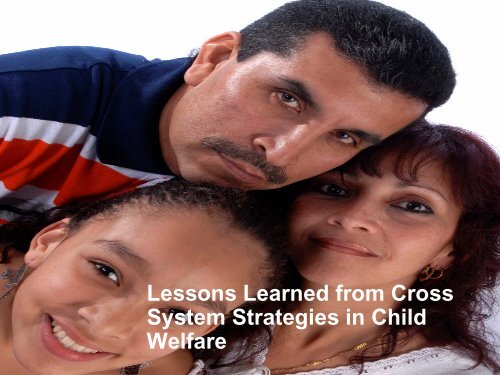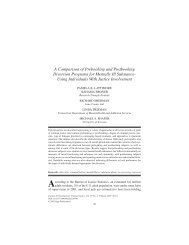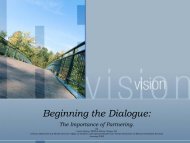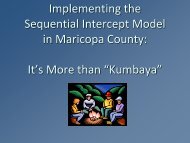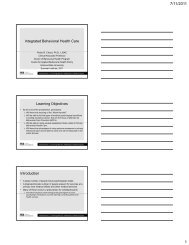Developing a Logical Framework and Plan for Conducting your ...
Developing a Logical Framework and Plan for Conducting your ...
Developing a Logical Framework and Plan for Conducting your ...
You also want an ePaper? Increase the reach of your titles
YUMPU automatically turns print PDFs into web optimized ePapers that Google loves.
Lessons Learned from Cross<br />
System Strategies in Child<br />
Welfare
Lessons Learned from Cross System<br />
Strategies in Child Welfare<br />
Panelists:<br />
•Nancy Hansen, MSW, DES/DCYF<br />
•Carmen<br />
Preciado, , LCSW, DES/DCYF<br />
•Ron<br />
Carpio, , MSW, TERROS<br />
•Jack Robinson MA, LPC, LISAC , TERROS<br />
•Tracy Stevens, M.A., Westcare Arizona<br />
•Jesus Gonzales , insert, SEABHS<br />
•Grace Diaz, B.A., AzPac
An Overview<br />
of the<br />
AFF Program
Why Did We Start This Work?<br />
Families, Child Welfare, TANF<br />
& Substance Abuse<br />
• Over 10 years, fueled by substance<br />
abuse, the number of abused <strong>and</strong><br />
neglected children has doubled:<br />
– 1986 – 1.4 million<br />
– 1997 – more than 3 million<br />
– Eight times greater than the increase in the<br />
children’s s population<br />
• * ”No Safe Haven”,Center on Addiction & Substance Abuse at Columbia University
Adoptions <strong>and</strong> Safe Families<br />
Act (ASFA)<br />
• ASFA was passed into law by Congress in 1997.<br />
• Congress was concerned over the length of time children<br />
were living in foster care<br />
• ASFA requires that the courts begin the process to<br />
terminate the parental rights of parents who have had<br />
children in foster care <strong>for</strong> 15 months out of the last 22<br />
months.<br />
• If a parent is in treatment <strong>for</strong> alcohol or drug abuse, they<br />
might not lose their parental rights if they stay in treatment,<br />
attend all court dates <strong>and</strong> show a desire/capcity<br />
to be<br />
reunited with their children.
Arizona Senate Bill<br />
1280<br />
• Innovative legislation - SB 1280 created<br />
AZ. Families F.I.R.S.T. (Families in<br />
Recovery Succeeding Together)<br />
• A Steering Committee chaired by the<br />
Governor’s s Office, with representation from<br />
the Legislature, the Judiciary <strong>and</strong> Child<br />
Advocacy guided ADES & ADHS in the<br />
development <strong>and</strong> implementation<br />
• Outcome Driven
What would it take<br />
to do this work?<br />
• Partnership between Arizona Departments of<br />
Economic Security <strong>and</strong> Health Services<br />
• Underst<strong>and</strong>ing systemic issues in Child<br />
Welfare, Employment, Substance Abuse &<br />
the Courts<br />
• Statewide change of substance abuse<br />
treatment <strong>for</strong> families in Child Welfare <strong>and</strong><br />
TANF towards Family Centered Practice
Legislative Outcomes<br />
Increase <strong>and</strong> improve the:<br />
• Availability<br />
• Timeliness<br />
• Accessibility<br />
of Substance Abuse Treatment
Per<strong>for</strong>mance Measures<br />
Reduction in:<br />
• Recurrence of child abuse <strong>and</strong> neglect<br />
• Substance abuse<br />
• # of days in foster care<br />
Increase in:<br />
• Obtaining or maintaining employment<br />
• # of children - permanency
Program<br />
Entry<br />
TANF<br />
CPS<br />
Report<br />
Arizona Families F.I .R.S.T. - SB 1280 Model<br />
Jobs<br />
CPS<br />
Pre-<br />
Screening<br />
Referral<br />
Case<br />
Management<br />
in DES<br />
Jobs<br />
Case<br />
Manager<br />
CPS<br />
Case<br />
Manager<br />
Screening, Service &<br />
Funding Coordination<br />
Outreach,<br />
Engagement<br />
& Screening<br />
Assessment<br />
Collaborative Partners<br />
Supportive Services<br />
• Child Care<br />
• Transportation<br />
• Housing<br />
Substance<br />
Abuse<br />
Education<br />
Out-Patient<br />
Intensive<br />
Out-Patient<br />
Residential<br />
Treatment<br />
Aftercare<br />
Within 24 hours Within 5 working Days<br />
Referral Screening Assessment<br />
Essential Elements<br />
• Outreach & Engagement<br />
•Motivat ional Interviewing & Ret ent ion<br />
•Relapse Ma na gement<br />
•Services <strong>for</strong> Children (Therapeutic Family Involvement)<br />
•Peer Support, Mentoring or Recovery Coaches<br />
•Gender-Specific Treatment<br />
•Family Focused & Child Centered<br />
• Culturally Responsive & Community Specif ic<br />
Referral to First Therapeutic Service - 14 days
Essential Elements<br />
• Outreach & Engagement<br />
• Motivational Interviewing & Retention<br />
• Relapse Prevention & Management<br />
• Gender-Specific Treatment<br />
• Family Focused & Child Centered<br />
• Culturally Responsive<br />
• Community Specific
Treatment Interventions<br />
• Outreach Engagement/Re<br />
Re-engagement.<br />
• Comprehensive Assessment.<br />
• Outpatient Substance Abuse Treatment.<br />
• Residential Treatment.<br />
• Case Management Services.<br />
• Supportive Services.<br />
• Aftercare Services.
Community Specific Best Practice<br />
Strategies<br />
• TERROS – Co Location<br />
• Westcare – Sober Living Environments<br />
• SEABHS – Integrated Family Teams<br />
• AzPac – Drug Court
TERROS, Inc.<br />
Families F.I.R.S.T. Co-location<br />
Project<br />
Ron Carpio, , MSW<br />
Jack Robinson MA, LPC, LISAC
Project History<br />
• Idea was presented in 2000<br />
• Challenge to sell to both parties<br />
• Team had experienced an unsuccessful<br />
attempt<br />
• Challenged by “Urban Legends”
Urban Legends<br />
• Clients will not come <strong>for</strong> services<br />
• Clients will be intimidated by CPS workers<br />
• Clients will not see treatment providers as<br />
separate from CPS<br />
• CPS will interrupt <strong>and</strong> distract clients<br />
• FF team building will be compromised.<br />
• Reduces staff’s s availability to provide client<br />
services<br />
• Client confidentiality will be compromised
Implementation Process<br />
• Established a co-location workgroup<br />
• Workgroup met monthly<br />
• Established pilot site<br />
• Worked out the “bugs”<br />
• Established next site<br />
• Developed co-location process
Project Overview<br />
• TERROS staff is co-located at 9 CPS sites<br />
• Provide SA expertise at TDM meetings<br />
• Improve coordination <strong>and</strong> communication<br />
• Forum to educate CPS staff on addiction <strong>and</strong><br />
addiction treatment.<br />
• Forum to educate FF staff on CPS responsibilities<br />
<strong>and</strong> philosophy.<br />
• Increase opportunities to engage families at the<br />
CPS offices
Families F.I.R.S.T. Co-Location<br />
Sites<br />
• DCYF District Office<br />
• 4000 North Central<br />
Ave<br />
• Glendale<br />
• Thunderbird<br />
• Gilbert<br />
• Avondale<br />
• Tempe<br />
• South Mountain<br />
• Talavi
SOBER HOUSING<br />
WestCare Arizona<br />
Tracy Stevens, M.A.<br />
Area Director<br />
Westcare Arizona
RURAL AREA<br />
• The sober living houses are located in<br />
Bullhead City, Arizona.<br />
• We are a desert area with extremely<br />
high temperatures.<br />
• We provide services to clients in<br />
Mohave <strong>and</strong> La Paz Counties which is<br />
approximately a 500 square mile area.
WHY IS IT A PROGRAM NEED<br />
• There are no Substance Abuse Residential<br />
facilities <strong>for</strong> people seeking treatment in Mohave<br />
or La Paz Counties.<br />
• Our 12 step community is very small.<br />
• There are a limited number of outpatient<br />
substance abuse treatment providers in either<br />
County.<br />
• Most clients in this area are on AHCCCS <strong>and</strong><br />
there is only one AHCCCS provider throughout<br />
Mohave County <strong>and</strong> only a couple in La Paz<br />
County.
HOW IT WORKS<br />
• Blossom House is a 90 day to 6 month program <strong>for</strong> women<br />
(children).<br />
• Emery House is 6 month program <strong>for</strong> men.<br />
• Highly structured <strong>and</strong> peer motivated.<br />
• Attendance at 12 step meetings daily.<br />
• Attendance at gender specific house meetings weekly.<br />
• Chores <strong>and</strong> curfews.<br />
• Resume <strong>and</strong> job search guidance.<br />
• Individual counseling available.<br />
• Substance abuse <strong>and</strong> domestic violence counseling<br />
provided at no cost.
HOW IT WORKS<br />
• R<strong>and</strong>om UA testing.<br />
• Bus tickets provided.<br />
• Vouchers <strong>for</strong> WestCare Thrift Store<br />
provided.<br />
• All household supplies, linens, dishes, etc…<br />
provided.<br />
• Staple foods provided.<br />
• Therapeutic environment.<br />
• Client’s s are required to seek <strong>and</strong> maintain<br />
employment.
BLOSSOM HOUSE
EMERY HOUSE
CHALLENGES<br />
• Clients often do not have the funds to<br />
pay <strong>for</strong> 1 st weeks rent.<br />
• Limited public transportation system.<br />
• Client’s s have minimal education.<br />
• Client’s s have very little prior work<br />
experience.<br />
• Due to criminal history, most client’s<br />
can only obtain employment at fast<br />
food restaurants.
CHALLENGES<br />
• The areas largest employers are the<br />
casinos. Many any client’s s are on<br />
probation <strong>and</strong> this makes getting<br />
fingerprint clearance almost<br />
impossible.<br />
• Since the houses are located in<br />
Bullhead City, most clients do not want<br />
to relocate to be in a sober<br />
environment.
SUCCESSES<br />
• Blossom House served 51 clients in<br />
2006. Approximately 35% (17) are still<br />
sober today.<br />
• Emery House served 65 clients in<br />
2006. Approximately 25% (16) are still<br />
sober today.<br />
• 8 women gave birth during their stay at<br />
Blossom House to Substance Free<br />
babies.
SUCCESSES<br />
• 75% of women were employed at the time of<br />
completion/discharge from Blossom House.<br />
• 85% of men were employed at the time of<br />
completion/discharge from Emery House.<br />
• United Way has provided scholarship money to<br />
help clients pay <strong>for</strong> first weeks rent.<br />
• Developed excellent relationships with community<br />
collaborators due to the success at both Emery<br />
<strong>and</strong> Blossom House.
SEABHS<br />
Integrated<br />
Family Team Process<br />
Jesus Gonzales<br />
“Integrating Child <strong>and</strong> Adult services”<br />
Revised 6/30/07
Integration of Child <strong>and</strong> Adult Services<br />
Through integration of the AZ Vision <strong>and</strong> 12<br />
Principles <strong>and</strong> the Principles of Person<br />
Centered <strong>Plan</strong>ning, SEABHS developed an<br />
integrated approach to serving families<br />
where the process is the same <strong>for</strong> everyone<br />
regardless of age, referral source, or focus<br />
of treatment.
Complex Needs Families<br />
Many of the families served by SEABHS have<br />
both parents <strong>and</strong> children enrolled in behavioral<br />
health services.<br />
These are often complex needs families with<br />
involvement in multiple state agencies including<br />
Child Protective Services (CPS), Adult or<br />
Juvenile Probation, Department of Corrections,<br />
etc.<br />
Traditional approaches to treatment have been<br />
unsuccessful <strong>for</strong> these families.
MCAS - Pregnant <strong>and</strong> post-partum partum substance<br />
abusing women. Services will be <strong>for</strong> the<br />
mother <strong>and</strong> the at risk child(ren).<br />
Arizona Families FIRST - Families involved in<br />
CPS as a result of substance abuse issues.<br />
Both MCAS <strong>and</strong> AFF populations are complex<br />
needs families <strong>and</strong> include referrals through<br />
the Arizona Families First program.
Coordination: Enrolled Parent <strong>and</strong> Child<br />
• Integrated services <strong>for</strong> the family<br />
• Single Family Team, including common members<br />
<strong>and</strong> client-specific members<br />
• Individualized service plan with<br />
common family objectives as well<br />
as individualized objectives<br />
• Common FT meeting with separate<br />
individual meetings as needed
SEABHS<br />
SUCCESS<br />
STORY
CHALLENGES
Drug Court<br />
Grace Diaz, B.A.<br />
AzFF Program Coordinator<br />
Catholic Charities
Overview of Family Drug Court<br />
• History: Drug<br />
Court began in<br />
February 1999 in<br />
Prescott<br />
• Purpose<br />
• Participants<br />
• Requirements
AFF Involvement<br />
• Collaboration with FDC started in Jan 2001<br />
• All FDC clients since 2001, have been AFF<br />
clients<br />
• Numbers: 166 as of 12/2006.<br />
• Facilitation of treatment services<br />
• Re-engagement<br />
engagement
Participation in the drug court<br />
staffing<br />
• Comprehensive update to<br />
the Judge<br />
• Drug screening results<br />
• Participation in treatment<br />
• Client’s s progress across<br />
multiple services<br />
• Problem solve with other<br />
team members around<br />
specific issues
Provision of supportive services<br />
• Facilitating acceptance into a halfway house<br />
• Transportation assistance to treatment related<br />
services.<br />
• Assisting with purchase of drug screening<br />
• Gender specific family counseling<br />
• Aftercare services to benefit reunification
Benefits to Clients<br />
Incentives<br />
• Praise from the judge<br />
• One on one dialogue with the Judge at each Court visit<br />
• Positive rein<strong>for</strong>cement<br />
• Reduction of community service time<br />
• Progression through the phases<br />
• Decrease in drug screen<br />
• Decrease in court appearances<br />
• Feeling of success<br />
Graduation rate 42%
Consequences/Sanctions<br />
• Warning from the Judge<br />
• Increase in 12-Step meetings<br />
• Additional community Service hour<br />
• Jail time<br />
• Increase in drug screens<br />
• Increase in Court appearance<br />
• Return to previous phase<br />
• Change in probation status<br />
• Termination from program <strong>and</strong> incarceration<br />
• Filing of a petition to sever parental rights
Upon successful completion <strong>and</strong> graduation<br />
participants may at that time benefit from:<br />
• Family reunification<br />
• Completion of drug treatment<br />
• Dismissal of charges<br />
• Honorable discharge from probation<br />
• Employment<br />
• Clean <strong>and</strong> sober lifestyle<br />
• Development of pro-social network
Outcomes<br />
• Drug Free babies<br />
born since<br />
inception of<br />
program<br />
• Children reunified<br />
• Development of<br />
healthy, sober,<br />
friendships<br />
• Creation of support<br />
systems.
Best practice<br />
approaches<br />
contribute to<br />
positive<br />
outcomes <strong>for</strong><br />
children <strong>and</strong><br />
families!
New AFF Referrals<br />
n = 4,727<br />
SFY 2006<br />
Referral Outreach<br />
n = 4665<br />
97% of new referrals<br />
Individuals Accepting Services<br />
n = 4,272<br />
90% of new referrals<br />
Individuals Assessed<br />
n =3,171<br />
67% of new referrals<br />
New AFF Clients<br />
n = 2,902<br />
72% of total AFF clients<br />
Coninuing AFF Clients<br />
n = 1,112<br />
28% of total AFF clients<br />
Total AFF Clients<br />
n = 4,014
Timeliness, Availability, <strong>and</strong><br />
Accessibility of Services<br />
• More than 16,400 individuals referred<br />
to the program in five years<br />
• Over 90% were contacted through<br />
outreach <strong>and</strong> engagement in five<br />
years<br />
• Rapid contact within a day or two<br />
• Nearly 70% received a substance<br />
abuse assessment<br />
• Coordinated <strong>and</strong> comprehensive<br />
array of services
Alcohol <strong>and</strong> Drug Problems<br />
(2006)<br />
• Over 50% of AFF clients reported using<br />
alcohol or illegal substances in the 30<br />
days prior to assessment<br />
• Most common substances used:<br />
– Methamphetamines – 29%<br />
– Alcohol – 26%<br />
– Marijuana – 24%<br />
– Cocaine/crack – 8%<br />
• Polysubstance use – 62%
• Over 60% of client program closures (n =<br />
1605) demonstrated no drug use at all<br />
during their participation in the program,<br />
as verified by drug screenings.
Child Safety <strong>and</strong> Reduction<br />
of Child Abuse <strong>and</strong> Neglect<br />
• Children of AFF caregivers experienced less<br />
subsequent neglect <strong>and</strong> abuse compared to<br />
state averages.<br />
– Out of 4,014 AFF clients, only 2% received a<br />
“substantiated” report finding based on one or<br />
more allegations filed subsequent to their<br />
enrollment in the AFF program.<br />
– Overall rate reported nationally <strong>for</strong> an 11-month<br />
period was 8% (Fluke et al, 2005).
Permanency <strong>for</strong> Children<br />
Through Reunification<br />
• Children of AFF caregivers achieved<br />
permanency at rates that exceeded<br />
the state average.<br />
– Over 900 children of AFF<br />
caregivers achieved permanency<br />
this year.<br />
– 68% of AFF children reunified.<br />
– 51% overall reunification rate<br />
reported by CPS <strong>for</strong> the period<br />
ending March 31, 2005.
In Summary<br />
• During the course state fiscal year 2006,<br />
4,014 individuals reported to Child Protective<br />
Services <strong>for</strong> neglect or abuse of their<br />
children, <strong>and</strong> known to have ongoing issues<br />
related to the use of alcohol <strong>and</strong> drugs, have<br />
been served by this innovative program.
• In 2006, more than 650 children have been<br />
returned to the custody of their parents without<br />
a recurrence of suspected neglect or abuse.<br />
• Parents have experienced success in<br />
addressing their substance use problems.<br />
• More than 60% of clients who completed their<br />
participation in AFF services demonstrated no<br />
drug use at all during their participation in the<br />
program, as verified by drug tests.
• Families have been able to access a<br />
seamless network of treatment services <strong>and</strong><br />
supports designed to promote ongoing<br />
recovery <strong>and</strong> family stability.
Conclusions<br />
Special design of this program facilitates:<br />
• Engagement of a hard to reach population<br />
• Bridging systems to enhance client outcomes<br />
• Integrating best practices to meet community<br />
need
Questions<br />
<strong>and</strong><br />
Answers
For More In<strong>for</strong>mation<br />
• Aimee Amado –<br />
DES/DCYF<br />
AAmado@azdes.gov<br />
• Carmen Preciado -<br />
DES/DCYF<br />
CPreciado@azdes.gov<br />
• Ron Carpio or<br />
Jack Robinson - TERROS<br />
Ronc@terros.org<br />
jackr@terros.org
For More In<strong>for</strong>mation<br />
• Kristi Johnson – Westcare Arizona<br />
kristi.johnson@westcare.com<br />
• Grace Diaz – AzPac/ / Catholic<br />
Charities<br />
GDiaz@cc-az.org<br />
az.org<br />
• Jesus Gonzales or Dan Barden –<br />
SEABHS<br />
JesusGonzales@seabhssolutions.org<br />
Dbarden@seabhssolutions.org


